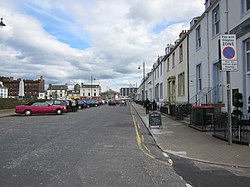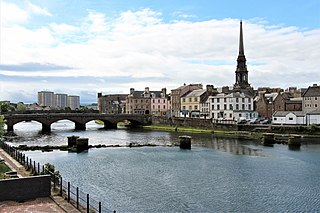
Ayr is a town situated on the southwest coast of Scotland. It is the administrative centre of the South Ayrshire council area and the historic county town of Ayrshire. With a population of 46,780, Ayr is the 15th largest settlement in Scotland. The town is contiguous with the smaller town of Prestwick to the north.

Yeomanry is a designation used by a number of units or sub-units of the British Army Reserve, descended from volunteer cavalry regiments. Today, Yeomanry units serve in a variety of different military roles.
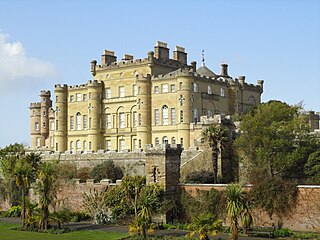
Culzean Castle is a castle overlooking the Firth of Clyde, near Maybole, Carrick, in South Ayrshire, on the west coast of Scotland. It is the former home of the Marquess of Ailsa, the chief of Clan Kennedy, but is now owned by the National Trust for Scotland. The clifftop castle lies within the Culzean Castle Country Park and is opened to the public. From 1972 until 2015, an illustration of the castle was featured on the reverse side of five pound notes issued by the Royal Bank of Scotland.

The Queen's Own Yeomanry (QOY) is one of the Army Reserve light armoured reconnaissance regiments.
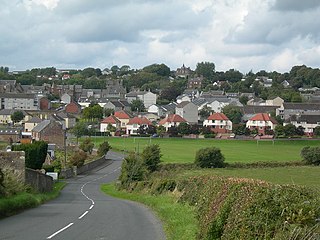
Maybole is a town and former burgh of barony and police burgh in South Ayrshire, Scotland. It had an estimated population of 4,580 in 2020. It is situated 9 miles (14 km) south of Ayr and 50 miles (80 km) southwest of Glasgow by the Glasgow and South Western Railway. The town is bypassed by the A77.

A Scottish regiment is any regiment that at some time in its history has or had a name that referred to Scotland or some part, thereof, and adopted items of Scottish dress. These regiments were created after the Acts of Union in 1707 between England and Scotland, either directly serving Britain during its various wars, or as part of the military establishments of Commonwealth countries. Their "Scottishness" is no longer necessarily due to recruitment in Scotland nor any proportion of members of Scottish ancestry.

The Lanarkshire Yeomanry was a yeomanry regiment of the British Army, first raised in 1819, which served as a dismounted infantry regiment in the First World War and provided two field artillery regiments in the Second World War, before being amalgamated into The Queen's Own Lowland Yeomanry in 1956. Its lineage was revived by B Squadron, the Scottish Yeomanry in 1992 until that unit was disbanded in 1999.

The Ayrshire Yeomanry was a Regiment of the British Yeomanry and is now an armoured Squadron of the Scottish and North Irish Yeomanry (SNIY), part of the British Army Reserve. It is the Lowlands of Scotland's only Royal Armoured Corps Unit and has an unbroken history stretching back to the 1790s.

The Lothians and Border Horse was a Yeomanry regiment, part of the British Territorial Army. It was ranked 36th in the Yeomanry order of precedence and was based in the Scottish Lowland area, recruiting in the Lothians – East Lothian (Haddingtonshire), Midlothian (Edinburghshire), and West Lothian (Linlithgowshire) – and along the border with England, particularly Berwickshire. It amalgamated with the Lanarkshire Yeomanry and the Queen's Own Royal Glasgow Yeomanry to form the Queen's Own Lowland Yeomanry in 1956.

The Scottish Yeomanry was a Yeomanry Regiment of the British Territorial Army formed in 1992. It was disbanded in 1999.
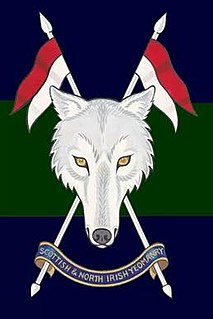
The Scottish and North Irish Yeomanry (SNIY) is a reserve Light Cavalry Regiment, formed in 2014, created out of the restructuring of the British Army's Territorial Army. It is operationally paired with The Royal Scots Dragoon Guards, based at Leuchars Station in Fife. The Regiment has numerous squadrons across Scotland and Northern Ireland.

The Titchfield Street drill hall is a former military installation in Kilmarnock.

The Tower Street drill hall is a military installation in York. It lies on Tower Street, in the city centre.

The Yorkhill Parade drill hall is a former military installation in Glasgow.

The Dundonald Street drill hall was a military installation in Edinburgh.

The High Street drill hall was a military installation in Dunkeld.

The Northgate Street drill hall is a former military installation in Warwick.

Minishant is a village bordering the A77 in the old county of Carrick, South Ayrshire, Scotland. It is located in Maybole Parish, 3+1⁄2 miles from Maybole and standing close to the River Doon. The village was originally named Culroy after the Culroy Burn that runs through it.

Ayr Town Hall is a municipal building in New Bridge Street, Ayr, Scotland. The town hall, which was the headquarters of Ayr Burgh Council, is a Category A listed building.
